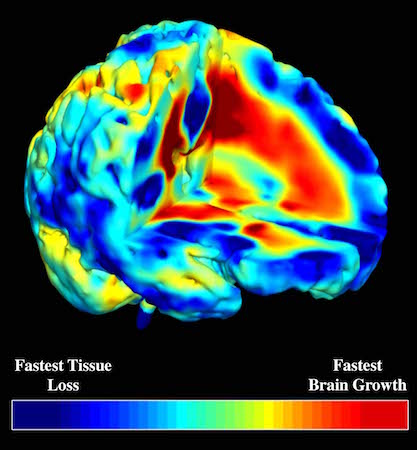Computational Anatomy & Shape Analyses
Tensor Based Morphometry and Shape
The brain undergoes a wide variety of morphological changes over time. These may occur during typical development or injury recovery, but might also be induced by disease or as effects of prescribed treatments. In order to track these changes, we are developing tensor-based methods which characterize volumetric differences between brain structures with dense (pointwise) correspondences. This work makes use of mathematics developed for continuum mechanics, e.g. elastic and fluid deformations. We are also developing non-linear image registration methods in the same vein.
The statistical analysis of the resulting deformation fields is conducted using Lie group methods and log-Euclidean metrics, which operate on the space of symmetric matrices. We are currently investigating similar methods for the deformation of tensor fields (e.g. those recovered via Diffusion Weighted MRI), as well as genetic influence over variations in the deformation maps.

Further Reading
- Hua X, Hibar DP, Ching CR, Boyle CP, Rajagopalan P, Gutman BA, Leow AD, Toga AW, Jack CR, Harvey D, Weiner MW. Unbiased tensor-based morphometry: improved robustness and sample size estimates for Alzheimer's disease clinical
trials. Neuroimage. 2013 Feb 1;66:648-61. [link]
- Fleishman GM, Gutman BA, Fletcher PT, Thompson PM. Simultaneous longitudinal registration with group-wise similarity prior. International Conference on Information Processing in Medical Imaging 2015 Jun 28 (pp. 746-757). Springer
International Publishing. [link]
- Gu X, Wang Y, Chan TF, Thompson PM, Yau ST. Genus zero surface conformal mapping and its application to brain surface mapping. IEEE Transactions on Medical Imaging. 2004 Aug;23(8):949-58. [link]
- Shi J, Thompson PM, Gutman B, Wang Y, Alzheimer's Disease Neuroimaging Initiative. Surface fluid registration of conformal representation: Application to detect disease burden and genetic influence on hippocampus. NeuroImage.
2013 Sep 30;78:111-34. [link]
- Wang Y, Zhang J, Gutman B, Chan TF, Becker JT, Aizenstein HJ, Lopez OL, Tamburo RJ, Toga AW, Thompson PM. Multivariate tensor-based morphometry on surfaces: application to mapping ventricular abnormalities in HIV/AIDS. NeuroImage.
2010 Feb 1;49(3):2141-57. [link]
- Gutman BA, Fletcher PT, Cardoso MJ, Fleishman GM, Lorenzi M, Thompson PM, Ourselin S. A Riemannian Framework for Intrinsic Comparison of Closed Genus-Zero Shapes. InInternational Conference on Information Processing in Medical Imaging 2015 Jun 28 (pp. 205-218). Springer International Publishing. [link]
Development
We are analyzing growth patterns during normal and abnormal brain development. There are some exciting findings, which we reported recently in the journal Nature, exploring the extremely complex dynamics of brain growth in children ranging from 6 to 15 years of age. Some very nice articles were written about these findings in the news media. Detailed maps of growth patterns in young children, who were scanned repeatedly with MRI, can be found here. Current work is creating time-lapse movies of brain development based on repeated MRI scans of children as they grow up. We are studying how these brain changes are accelerated or derailed in children and teenagers who develop schizophrenia, or bipolar disorder. We are also developing new brain mapping techniques to help study brain changes in developmental disorders. We are mapping cortical and subcortical structural differences in autistic children and Fragile X syndrome. Another project maps subtle cortical abnormalities in a genetic disorder of brain development: Williams syndrome, where we recently mapped the profile of cortical abnormalities.

Further Reading
- Gogtay N, Giedd JN, Lusk L, Hayashi KM, Greenstein D, Vaituzis AC, Nugent TF, Herman DH, Clasen LS, Toga AW, Rapoport JL. Dynamic mapping of human cortical development during childhood through early adulthood. Proceedings of the National academy of Sciences of the United States of America. 2004 May 25;101(21):8174-9. [link]